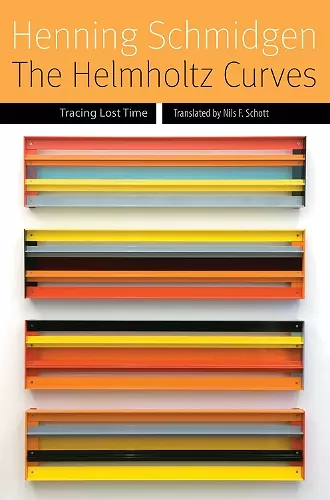The Helmholtz Curves
Tracing Lost Time
Henning Schmidgen author Nils F Schott translator
Format:Hardback
Publisher:Fordham University Press
Published:15th Sep '14
Currently unavailable, and unfortunately no date known when it will be back
This hardback is available in another edition too:
- Paperback£22.99(9780823261956)

This book reconstructs the emergence of the phenomenon of “lost time” by engaging with two of the most significant time experts of the nineteenth century: the German physiologist Hermann von Helmholtz and the French writer Marcel Proust.
Its starting point is the archival discovery of curve images that Helmholtz produced in the context of pathbreaking experiments on the temporality of the nervous system in 1851. With a “frog drawing machine,” Helmholtz established the temporal gap between stimulus and response that has remained a core issue in debates between neuroscientists and philosophers.
When naming the recorded phenomena, Helmholtz introduced the term temps perdu, or lost time. Proust had excellent contacts with the biomedical world of late-nineteenth-century Paris, and he was familiar with this term and physiological tracing technologies behind it. Drawing on the machine philosophy of Deleuze, Schmidgen highlights the resemblance between the machinic assemblages and rhizomatic networks within which Helmholtz and Proust pursued their respective projects.
"Grounded in archival sources, Schmidgen's book is a must-read for any historian of science interested in nineteenth-century physiology." -Isis Review "The distinguished German scientist, Hermann von Helmholtz, and the superb French writer, Marcel Proust, never met. However, Henning Schmidgen's fascinating study of nineteenth century graphic machines, tracings, and early photography reveals how their shared preoccupation with the physiology and mechanics of muscles and nerves, however disparate, led them to remarkably similar discoveries about the arbitrary and unpredictable modern experience of time." -- -Anson Rabinbach Princeton University, author of The Human Motor "Henning Schmidgen's exciting book is about laboratory practices and reaction time measurements, but it is as much a beautifully written map of visual culture of scientific experiments, the measured body, and the emergence of a modern sense of time. Schmidgen offers us an excellent piece of scholarship on scientific and technological culture that also demonstrates the importance of a Deleuzian history of science for the history of media." -- -Jussi Parikka University of Southampton, author of What is Media Archaeology? "The Helmholtz Curves presents an archival discovery of the greatest importance not just to historians of science but to every scientist who studies the nervous system." -- -Laura Otis Emory University "This is a remarkable book. Starting from two images of graphic curves taken by Hermann von Helmholtz in 1851 in Konigsberg and preserved in the archives of the Academie des Sciences in Paris, Henning Schmidgen unfolds the universe of physiological time measurement as it took shape around the middle of the 19th century, reaching deep into the 20th century with its reverberations. Like in a burning glass, the book aligns the components of a new laboratory regime and their entanglement with the dawning age of energy conversion and of - electromagnetic - communication and social control. The central figure holding the story together is a little 'gap': the fraction of a second in which, between stimulus and response, nothing appears to happen - a time lost and yet of tremendous cultural brisance." -- -Hans-Jorg Rheinberger Director at the Max Planck-Institute for the History of Science
ISBN: 9780823261949
Dimensions: unknown
Weight: unknown
248 pages